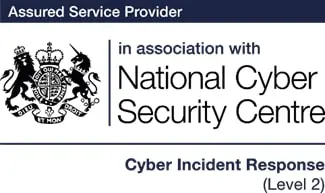How to protect your data and assets from cyber threats
What are Managed Detection and Response (MDR) Services?

In today’s digital age, cybersecurity threats are becoming increasingly complex and sophisticated. It’s no longer a matter of if, but when a cyber attack will occur.
With cyberattacks becoming more sophisticated, it is essential to have a proactive approach to cybersecurity.
Managed detection and response services offer organisations a proactive approach to cybersecurity that combines people, processes, and technology to identify and respond to cyber threats.
Managed detection and response services are delivered by a team of experts who monitor and manage security events, investigate suspicious activity, and respond to security incidents.
MDR providers offer a range of cyber security services to help organisations to identify and respond to cyber threats.
These services can cover everything from threat intelligence and endpoint detection and response to incident response and threat hunting.
Managed detection and response services reduce the time to detect and respond to cyber incidents and improve overall security posture.
The demand for MDR services is growing rapidly, with Gartner predicting that 50% of organisations will use MDR services by 2025.
Many organisations are turning to MDR services to help them hunt, mitigate, and contain cyberthreats, as an average security team receives more than 10,000 alerts daily


53%
have experienced a successful cyber attack in the past 12 months

65%
say that their biggest cybersecurity challenge is a lack of skilled personnel

80%
said that MDR had improved their security posture
What does Managed Detection and Response (MDR) do?
How does MDR benefit your business?
Managed Detection and Response (MDR) is a service that provides organisations of all sizes, and from all industries, the capabilities to proactively detect and respond to cyber threats.
The MDR service market is expected to reach $2.2 billion by 2025, with 50% of organisations predicted to use MDR services by that year.
Managed detection and response services typically include proactive response, cyberthreat hunting, and 24/7 operations.
They provide several benefits to businesses, such as enhancing security posture, providing real-time threat monitoring, advanced threat monitoring and threat detection, faster incident response, and threat intelligence.


The cyber security workforce gap grew in 2022 by just over 26%, with the gap reaching a deficit of 3.4 million workers globally. MDR services are a cost-effective solution for organisations struggling to acquire and maintain highly skilled personnel and resources in-house.
Managed detection and response services provide highly skilled security analysts who have access to cutting-edge security tools and the latest global threat databases, beyond the reach of most organisations.
MDR services can also integrate Endpoint Detection and Response (EDR) tools that become a challenge for security operations teams to learn and maintain.
With managed detection and response services in place, detection levels are improved, while dwell time of breaches is reduced.
Compliance challenges can also be met using managed detection and response services, providing full stakeholder reporting and log retention on a wide range of regulations and standards.
Discuss your cyber security options
Get in touch today to speak to an expert and secure your business, or call us on 0800 090 3734
What are the benefits of Managed Detection and Response Services?
Why are organisations turning to Managed Detection and Response (MDR) Services?
Managed Detection and Response (MDR) services offer numerous benefits to businesses of all sizes, especially those that lack the necessary resources to manage their cybersecurity in-house.
These benefits can help businesses protect their networks and data.
The key benefits of managed threat detection and response services include proactive threat monitoring, rapid response, access to cybersecurity expertise, cost-effectiveness, enhanced visibility, scalability, threat intelligence, endpoint detection and response, incident response, threat hunting, advanced threat detection, vulnerability management, improved forensics, and higher-level investigations.
Some of the most significant benefits of managed detection and response services are included here.

MDR services provide continuous monitoring and threat detection to identify any suspicious activity in real-time. They use a combination of advanced MDR tools and techniques to identify threats, including machine learning algorithms and behavioral analytics.
MDR services provide a rapid response to any detected threats, ensuring that they are contained and remediated before they can cause significant damage to your network or data. In the event of a cyber attack, time is of the essence. MDR providers have response teams that are available around the clock.
MDR services use advanced analytics to provide detailed insights into your network and data. This allows you to identify vulnerabilities and improve your security posture.
MDR services can be customised to meet your specific security needs. This ensures that you get the level of protection you need without paying for services that you don’t. No two companies are the same – your MDR provider must prove that they understand this and not look to sell you a solution that isn’t fit for purpose.
MDR services provide round-the-clock monitoring and response, ensuring your network and data are always protected.
MDR services provide access to a team of security experts who can help you navigate complex security challenges and develop an effective cybersecurity strategy.
MDR services are a cost-effective solution for organisations looking to enhance their cybersecurity posture. They provide access to a range of cybersecurity services without the need for an expensive dedicated cybersecurity team and tooling.
MDR services provide enhanced visibility into an organisation’s entire infrastructure, including networks, endpoints, and cloud infrastructure. This provides you with the ability to detect and respond to threats across your entire environment.
MDR providers can easily scale their services to meet your business needs, whether you’re a small business or a large enterprise. Smaller businesses can achieve the same level of security as larger enterprises, without the need for significant investment in infrastructure.
MDR providers help businesses to stay compliant with industry regulations and standards by implementing security controls that meet or exceed these requirements.
How MDR works
Why use Managed Detection and Response Services?
Managed Detection and Response (MDR) services are a proactive approach to threat detection and incident response.
MDR services offer 24×7 security operations coverage, enabling customers to leverage the expertise of the provider’s MDR SOC (Security Operations Centre) teams.
Through endpoint detection and response (EDR) tools, MDR services can remotely monitor, detect, and respond to threats within an organisation’s infrastructure.
With access to threat intelligence feeds and a team of cybersecurity experts who are constantly monitoring the network for potential threats, MDR services can provide the best possible protection against cyber threats.
Managed Detection and Response service capabilities sit within 5 key phases of securing an organisation’s infrastructure:
Discuss your cyber security options
Get in touch today to speak to an expert and secure your business, or call us on 0800 090 3734
Choosing the right MDR services
What should you consider when selecting a Managed Detection and Response provider?
Managed Detection and Response (MDR) services provide a range of services to complement an organisation’s existing security investment.
But with so many MDR providers on the market, how can you choose the best MDR provider for your business?
By asking the right questions, you can find the best MDR provider for your business. It’s vitally important that you ask questions to ensure that your sensitive data and networks are protected from cyber threats.
Here are some key factors to consider:
Before you start your search for a MDR providers, take the time to assess your current security capabilities and identify any gaps or weaknesses that need to be addressed.
This can be achieved through penetration testing services. Continuous penetration testing can provide an ongoing view of vulnerabilities alongside the MDR service, to evaluate security threats before a hacker has a chance to exploit them. This will help you narrow down your search to providers that can offer the specific services and expertise that you need.
Look for a managed detection and response provider with a team of experienced security analysts who possess the skills and knowledge necessary to detect and respond to a wide range of cyber threats.
Ask potential MDR providers about the qualifications and experience of their staff, as well as the types of training and professional development opportunities they offer to keep their skills current.
The effectiveness of an MDR solution depends on its ability to access and analyse the right data in real-time.
Look for a provider with a managed detection and response solution that can easily integrate with your existing systems and provide you with the necessary visibility and insights to detect and respond to threats quickly.
Choose an MDR provider that has a streamlined communication process and can seamlessly integrate with your team’s workflow. This will ensure that any incidents or threats are identified and addressed quickly, without disrupting your business operations.
It’s important to understand the provider’s definition of response. Ask them about their proactive response capabilities, to what extent response actions are automated, your role in response actions, and the approval process for response actions.
Cyber threats can happen at any time, so it’s important to choose an MDR provider that offers 24/7/365 coverage.
This will ensure that any incidents or threats are identified and addressed quickly, even during off-hours. It’s important to ask MDR providers about their staffing levels outside of standard business hours.
Look for an MDR provider that incorporates threat hunting as part of their services.
This will allow them to proactively search for and identify potential threats before they have a chance to cause damage. Cyberthreat hunting requires specialist expertise and relevant, contextualised threat intelligence.
Look for an MDR provider that can provide you with clear performance metrics and regular reporting on their activities.
This will allow you to assess the effectiveness of their services and make any necessary adjustments to your security strategy.
How should you choose a Managed Detection and Response provider?
When searching for the right MDR solution, it’s important to evaluate their services in three key areas: response, threat hunting, and 24/7 service.
Here are five key questions to ask MDR vendors as you begin your research:
- What level of expertise and certifications do the MDR SOC analysts hold?
- Does the MDR service have access to the data and systems needed to be effective?
- How does your MDR SOC team stay up to date on the latest cyber threats?
- How will the MDR provider communicate with your team?
- Is the managed threat detection and response service 24/7?

Discuss your cyber security options
Get in touch today to speak to an expert and secure your business, or call us on 0800 090 3734
DigitalXRAID’s 24/7 managed detection and response service
DigitalXRAID’s 24/7 Managed Detection and Response service is a leading cyber security service that responds to all cyber threats to your IT infrastructure, every day of the year.
DigitalXRAID’s Managed Detection and Response service operates on a 24/7/365 basis, with a dedicated team of MDR SOC analysts monitoring networks, systems, and applications, keeping them secure and responding to security events in real time.
Our security analysts operate as an extension of your own team, working seamlessly to provide world-class managed threat detection and response to identify and neutralise an attack in less than 6 minutes.
The service can uniquely supply the complete spectrum of advanced threat detection and response capabilities, more recently coined as XDR (extended detection and response).
Services within the XDR solution include vulnerability management, IDS & IPS, threat mining, SOAR (Secure Orchestration and Response), SIEM & log management, endpoint detection and response, file integrity monitoring, dark web monitoring and full compliance reporting.
If you’re interested in learning more about SOC security or how the Managed Detection and Response service can protect your business, get an MDR service quote tailored to your business needs.
What's different about our managed detection and response (MDR) service?
Best-of-breed tooling:
The managed detection and response (MDR) service provides state-of-the-art tooling and expertise, for less than the cost of one InfoSec employee.
DigitalXRAID’s Security Operations Centre service is completely impartial, not looking to push any particular security software or solutions sale but is able to offer advice which is in the best interests of the customer
24/7 monitoring:
The managed detection and response service operates 24/7/365 with some of the highest qualified security professionals in the world. The SOC is one of the first in the world to hold CREST certification and continues to be in the top 1% globally with this certification.
Expertise and qualifications:
Our MDR SOC analysts hold the highest level of security qualifications including CCIE Security and CISSP certifications, amongst others.
Unlike other providers, DigitalXRAID has achieved government-grade security accreditations on top of the elite CREST certification, with ISO 9001 for Quality Management Systems, ISO 20000 for IT Service Management and Cyber Essentials data security certifications added for complete peace of mind for customers.
To protect your business and your reputation and learn more about our MDR service:
Talk to the TeamThreat Intelligence
The Hive: Threat Intelligence
DigitalXRAID’s Threat Intelligence draws from the most comprehensive picture of the current state of cybersecurity.
DigitalXRAID’s SOC analysts and CTI specialists are fed data from the entire internet, every day, to map out adversaries and their infrastructure. This gives the SOC team greater visibility into the hidden sites where cybercriminals instigate their attacks and enhances proactive threat protection.
Enquire about SOC

Flexible Pricing Options
No hidden costs. Transparent future pricing
To provide flexibility for our customers, our pricing structure is offered across three solution types: Essentials, Core, and Proactive SOC.
These offerings allow customers to choose the correct solution that meets their specific needs and budget, rather than being forced into a one-size-fits-all solution.
Enquire about SOCBespoke Customer Service
Big Enough to Deliver, Small Enough to Care
We understand that no two customers are the same. Your reputation is DigitalXRAID’s reputation.
We deliver a bespoke proactive SOC solution tailored to your specific needs. We’re not trying to push a one size fits all technical partner solution.
Enquire about SOC

Tailored offerings
Flexibility & Customer First
All the development of your SOC, including use cases and tuning, becomes your intellectual property. We do not hold customers to ransom or compel them to stay with us due to the complexity of leaving.
Our customers stay with us because we deliver exceptional customer service, provide bespoke offerings tailored to their requirements, continuously improve the service, and offer use case development and threat intelligence.
Our goal is to be an extension of your team.
Enquire about SOCManaged Detection and Response Q&A
What are the key components of a Managed Detection and Response Solution?
Managed Detection and Response (MDR) services offer a variety of features that are designed to detect and respond to cyber threats effectively. With these features, MDR services are crucial for businesses to secure their network from cyber threats.
These are some of the key features of managed detection and response services that businesses must look for, to ensure the best security posture and protection against cyber threats:
Threat Hunting:
One of the key features of managed threat detection and response services is the ability to hunt for potential security threats on your network. This includes identifying suspicious activity, investigating potential breaches, and conducting forensics analysis. With the help of advanced MDR tools and techniques, MDR providers can detect threats that may not be apparent through traditional signature-based methods.
Incident Response:
MDR services provide rapid incident response to any detected threats. This includes isolating affected systems, containing the damage, and remediating any vulnerabilities. This helps organisations to minimise the impact of any security breach that may occur and ensures that the network gets back to a safe and usable state quickly to avoid any business interruption.
Event Management:
Managed detection and response services provide centralised event management, allowing security events to be monitored across the entire network. This helps organisations to have visibility into and keep track of all security events, respond to potential threats, and manage their security posture more effectively.
Threat Intelligence:
MDR services use advanced threat intelligence tools to identify emerging threats and provide actionable insights into your security posture. This helps businesses to stay ahead of the ever-evolving threat landscape and mitigate potential risks proactively.
Endpoint Detection:
Managed detection and response services provide endpoint detection and response as one feature within the overall service. This is an essential part of the MDR service as endpoints are the most vulnerable part of the network and are often targeted by cybercriminals.
Endpoint detection and response (EDR) and managed detection and response (MDR) services are two of the most popular cybersecurity solutions that organisations use to secure their IT infrastructure. While EDR solutions are designed to provide visibility into endpoint activity and detect and respond to threats, MDR services take a more holistic approach to cybersecurity.
Here are the key differences between MDR and EDR:
- EDR solutions are typically focused on endpoint detection and response, while MDR services provide end-to-end threat detection and response capabilities, including network monitoring, threat intelligence, incident response, and more.
- EDR solutions record and store endpoint behaviours and events and feed them into rules-based automated responses and analysis systems. When an anomaly is detected, it is sent to the security team for human investigation. MDR services, on the other hand, introduce human expertise, mature processes, and threat intelligence to provide more comprehensive and effective detection and response capabilities.
- Many in-house security teams lack the resources and time to fully utilise their EDR systems, which can leave an organisation less secure than before it purchased its EDR solution. MDR services help to solve this problem by leveraging the expertise of external security providers to better detect and respond to threats that can come from an endpoint, as well as network, user, and cloud threats.
- While EDR is a valuable component of an enterprise’s behavioural analysis infrastructure, it is most effective when integrated with an extended detection and response (XDR) system. XDR solutions help to consolidate and correlate data from multiple sources, including EDR, network traffic analysis, and cloud services, to provide a more comprehensive view of the threat landscape.
Managed security services have become increasingly important as organisations look to manage their external security needs. These services can range from firewall management to intrusion detection and prevention, and security information and event management. One of the key players in this space is the Managed Security Service Provider (MSSP), which offers a range of services to help organisations manage their security needs.
While some MSSPs offer Managed Detection and Response (MDR) services, they are not the same thing. MDR is a specific service designed to detect and respond to advanced threats. This service utilises advanced technologies such as machine learning and behavioral analytics to identify and respond to threats that traditional security solutions may not catch. MDR services are tightly focused on detecting and responding to emerging threats quickly and delivering mitigation and remediation capabilities.
MSSPs, on the other hand, typically provide broad monitoring of the network for events and send validated alerts to other tools or the security team. They also offer a range of other services such as technology management, upgrades, compliance, and vulnerability management. However, they generally do not actively respond to threats, leaving that responsibility to the customer. As a result, MSSP customers may need to engage additional consultants or vendors to perform mitigation and remediation.
MDR providers offer a more specialised service compared to MSSPs. They can detect lateral movement within a network and utilise advanced threat detection techniques to identify and respond to emerging threats quickly. MDR providers carry out 24/7 continuous monitoring, which may not be offered by some MSSPs. They also offer extensive forensics, threat research, and analytics to help organisations understand and respond to threats more effectively.
MDR and SIEM are two different approaches to detecting and responding to security threats. SIEM is a broad technology category that involves aggregating data from various network sources and analysing it to detect anomalies that could indicate suspicious activity. While SIEMs vary in their capabilities, they all share the same basic function of collecting and analysing security data.
MDR services, on the other hand, are designed to quickly detect and respond to advanced security threats. MDR providers use advanced technologies like machine learning and behavioral analytics to identify threats that may not be caught by traditional security solutions. MDR services have a light network footprint and can deliver immediate value with minimal investment.
While SIEMs focus on identifying potential threats, MDR services go a step further by providing mitigation and remediation capabilities. MDR services can detect lateral movement within a network and deliver recommendations for remediation to the security team. This proactive approach helps to prevent attacks from spreading throughout the network.
Read more on managed SIEM
Managed detection and response (MDR) is a managed security service that provides a more proactive approach to threat detection and response. It uses advanced technologies like machine learning and behavioral analytics to identify and respond to advanced threats that may not be caught by traditional security solutions. MDR services are tightly focused on detecting and responding to emerging threats quickly, and typically include mitigation and remediation capabilities.
A Security Operations Centre (SOC), on the other hand, is a centralised team or facility that is responsible for monitoring, analysing, and responding to security incidents. It typically consists of a team of security analysts who use a variety of security tools and technologies to monitor and analyse network activity, identify security threats, and respond to security incidents. A SOC can be an internal function but often organisations use an outsourced SOC and managed SOC services, to benefit from a lower total cost of ownership.
In the rapidly evolving landscape of cybersecurity, organisations are turning to advanced security solutions to protect their assets.
One such solution is Extended Detection and Response (XDR), a platform that can unify and transform telemetry data from multiple sources beyond the endpoint.
By utilising XDR, security teams can detect and respond to threats at a faster pace than ever before. Managed Detection and Response (MDR) is another powerful service that can help organisations detect and respond to advanced threats.
Many MDR providers are now incorporating XDR capabilities as part of their offering to provide a comprehensive security solution that covers the entire modern environment of their customers. By combining the power of XDR with MDR, organisations can achieve a more robust and effective security posture.
Protect Your Business & Your Reputation.
With a continued focus on security, you can rest assured that breaches and exploits won't be holding you back.










